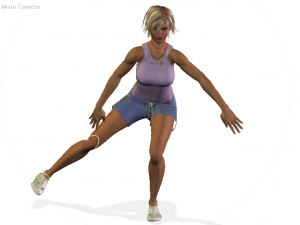Purpose: Demonstrate a case of an altered nerve tension in a runner that may be exacerbated by their running technique.
Case Details
Female, late twenties, competitive runner (sub 20 minute 5km, 1:30 half marathon, 3:15 full marathon)
Audience: Therapists
Purpose: I like the idea of quantifying the “dosage” of an exercise. We can do this with EMG and this post will be part of a larger theme that catalogues the EMG amplitude of various shoulder rehabilitation exercises. Further, it will also try to justify a number of exercises for their ability to avoid negative loading on the shoulder and promote a possibly optimal way of working the shoulder.
Caveat: This review only looks at a few papers addressing the Upper Traps (UT) to Serratus Anterior (SA) ratio. Other exercises must obviously be incorporated into a rehab program.
Exercises to maximize the Serratus Anterior (SA) to Upper Trapezius (UT) Ratio
To simplify: SA = good, UT = bad. Basically, activation of the SA moves the scapula out of the way of the humerus while too much or too early activation of the UT tends to
anteriorly tilt the scapula and decrease the space for humeral movement. Ann Cools has done extensive work in this area. Here is a taste of her findings and recommendations. You may want to consider using the exercises when you have a little scapular dyskinesis on your hands - you may see some medial border prominence of the scap, some winging during arm elevation and the scap can get a little jiggy with arm raising and lowering. (more…)
 Attached is a basic exercise protocol as part of a large physiotherapy regime I might use for someone with some lower extremity dysfunction. Many of these exercises would be used for non specific knee pain (PFPS, ITB syndrome). The nordic hamstring exercise could be skipped but should certainly be used for anyone with posterior chain weakness/dysfunction. I use that ol’ nebulous word ‘dysfunction’ when something is wrong (e.g. pain) but I’m not willing to commit to some BS therapist jargon about the cause of the problem. You could put in the same room 5 great therapists (physiotherapists, chiropractors, massage therapists, sport med docs) who could all get someone better but they would each explain the problem completely different and often contradict each other. So, I use the general word dysfunction. (more…)
Attached is a basic exercise protocol as part of a large physiotherapy regime I might use for someone with some lower extremity dysfunction. Many of these exercises would be used for non specific knee pain (PFPS, ITB syndrome). The nordic hamstring exercise could be skipped but should certainly be used for anyone with posterior chain weakness/dysfunction. I use that ol’ nebulous word ‘dysfunction’ when something is wrong (e.g. pain) but I’m not willing to commit to some BS therapist jargon about the cause of the problem. You could put in the same room 5 great therapists (physiotherapists, chiropractors, massage therapists, sport med docs) who could all get someone better but they would each explain the problem completely different and often contradict each other. So, I use the general word dysfunction. (more…)
Audience: Health professionals
I used to be a researcher (exercise biomechanics, physiotherapy, chiropractic) - one of my goals was to quantify how hard muscles worked during different exercises. This was important for determining which exercises may be best for targeting a certain muscle or determining how modifications to exercises (e.g. doing it barefoot or on a wobbly surface - for a simple paper look here) changed the targeted muscles response.
I used surface EMG which quantifies the electrical activity of that portion of a muscle that was under the electrodes. Surface EMG is messy and you are required to process the crap out of it to get something meaningful. (more…)
Stu McGill was an author on this paper when it came out back in 1998. At the time, I was one of Stu’s grad students putting electrodes onto anyone I could find for the price of Gyro sandwich. I even burned (chemically and transiently) the thigh of a girlfriend at the time. I knew how to treat the ladies. Unfortunately, I never really picked Stu’s brain about this paper. It was only relevant to me at the time because we were strongly questioning the necessity of double leg lifts as an exercise for the “lower abs”. We felt they were unnecessary to recruit the lower abs and too costly because of the compressive and anterior shear component applied to the lumbar spine. Our argument was that there is no difference between the upper section of the rectus abdominis and the lower section. I still stand by it and the paper is here ( http://ptjournal.apta.org/content/81/5/1096.full ). Regardless of my youthful oversight, I still love the paper and the ideas of sticking needles into the psoas. It must feel awesome hence the “n” of only 5. Below are a few tidbits that will lead into future posts on psoas function. (more…)